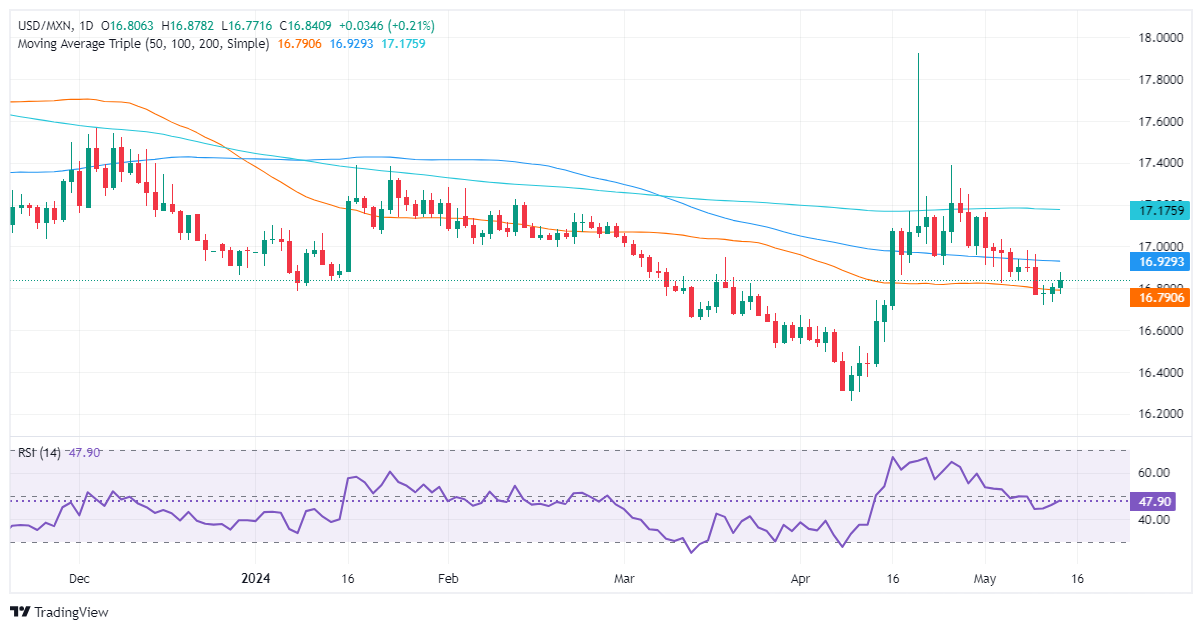- Mexican Peso drops down for second day, losing 0.24%.
- Powell's cautious inflation remarks and potential for ongoing tight policy boost USD, aided by high April PPI.
- Contrasting Powell, Banxico's Ceja hints at possible rate cuts, contributing to Peso's decline ahead of June 27 meeting.
The Mexican Peso extended its losses against the US Dollar for the second straight day, following hawkish remarks by Federal Reserve (Fed) Chair Jerome Powell and dovish remarks by Bank of Mexico Governor Victoria Rodriguez Ceja. The Mexican currency is down 0.56% in the week. The USD/MXN trades at 16.84 and records gains of 0.24%.
Fed Chair Jerome Powell said he’s not expecting a “smooth road on inflation,” adding that it is moving lower and that “my confidence on that is not as high as it was before.” He expects the Gross Domestic Product (GDP) to grow by 2% or better with a strong labor market.
Powell noted that restrictive monetary policy “may” take longer than expected to do its work and bring inflation to the Fed’s 2% goal.
For the latest news about the Mexican Peso click here.
Earlier, the US Department of Labor revealed that the Producer Price Index (PPI) for April was higher than expected, in some measures, prompting investors to buy the Greenback. US Treasury yields edged up, while US equities trended lower before recovering at the time of writing.
On Monday, Bank of Mexico (Banxico) Governor Victoria Rodriguez Ceja said, “We could evaluate downward adjustments” to the main reference rate. She added that while general inflation has continued to rise, underlying prices have not. Therefore, depending on the evolution of the inflationary outlook, Banxico could evaluate continuing its easing cycle as soon as the next meeting on June 27. These comments came after the Mexican central bank kept the main reference rate unchanged at 11% last Thursday.
Daily digest market movers: Mexican Peso drops on Powell’s remarks
- Mexico’s economic docket will be absent during the current week. The next economic data released would be Retail Sales expected on May 20, followed by the Gross Domestic Product (GDP), inflation figures and the release of Banxico’s minutes on May 23.
- April's data show that Mexico’s headline inflation is reaccelerating. However, core prices are falling. This spurred Banxico’s revision to its inflation projections, with the bank expected to hit its 3% target toward the last quarter of 2025, later than March’s estimates for Q2 2025. Core inflation is projected to hit 3% in Q2 2025.
- The US Bureau of Labor Statistics (BLS) revealed that the PPI rose 0.5% MoM, exceeding forecasts of a dip to 0.3%, with core PPI also expanding at the same pace as headline data, above estimates of 0.2%. Both readings were above March’s -0.1% drop in general and underlying inflation.
- After the report, investors trimmed bets that the Fed may cut rates faster than expected, though the odds for a September cut have lately adjusted to 83.6%, higher than Monday’s 79%.
- The deterioration in consumer sentiment, alongside a cooling labor market, has opened the door for investors to price in rate cuts by the Fed. This is because US central bank policymakers acknowledged that risks to achieving its dual mandate on employment and inflation “moved toward better balance over the past year.”
Technical analysis: Mexican Peso falls as USD/MXN rises above 16.80
The USD/MXN downtrend remains in play, even though buyers lifted the pair above Friday’s close, which could pave the way for a leg up. In the near term, momentum remains bearish, but the Relative Strength Index (RSI) aiming upward suggests that buyers are in charge.
At the time of writing, the USD/MXN is shy of conquering the 100-day Simple Moving Average (SMA) at 16.92. Once cleared, the next supply zone would be the 17.00 psychological level. A breach of the latter would expose the 200-day SMA at 17.17, followed by the January 23 swing high of 17.38 and the year-to-date high of 17.92.
On the other hand, a bearish continuation could resume if the USD/MXN tumbles below the 50-day SMA at 16.78, opening the door to test the 2023 low of 16.62, followed by the current year-to-date low of 16.25.
Mexican Peso FAQs
The Mexican Peso (MXN) is the most traded currency among its Latin American peers. Its value is broadly determined by the performance of the Mexican economy, the country’s central bank’s policy, the amount of foreign investment in the country and even the levels of remittances sent by Mexicans who live abroad, particularly in the United States. Geopolitical trends can also move MXN: for example, the process of nearshoring – or the decision by some firms to relocate manufacturing capacity and supply chains closer to their home countries – is also seen as a catalyst for the Mexican currency as the country is considered a key manufacturing hub in the American continent. Another catalyst for MXN is Oil prices as Mexico is a key exporter of the commodity.
The main objective of Mexico’s central bank, also known as Banxico, is to maintain inflation at low and stable levels (at or close to its target of 3%, the midpoint in a tolerance band of between 2% and 4%). To this end, the bank sets an appropriate level of interest rates. When inflation is too high, Banxico will attempt to tame it by raising interest rates, making it more expensive for households and businesses to borrow money, thus cooling demand and the overall economy. Higher interest rates are generally positive for the Mexican Peso (MXN) as they lead to higher yields, making the country a more attractive place for investors. On the contrary, lower interest rates tend to weaken MXN.
Macroeconomic data releases are key to assess the state of the economy and can have an impact on the Mexican Peso (MXN) valuation. A strong Mexican economy, based on high economic growth, low unemployment and high confidence is good for MXN. Not only does it attract more foreign investment but it may encourage the Bank of Mexico (Banxico) to increase interest rates, particularly if this strength comes together with elevated inflation. However, if economic data is weak, MXN is likely to depreciate.
As an emerging-market currency, the Mexican Peso (MXN) tends to strive during risk-on periods, or when investors perceive that broader market risks are low and thus are eager to engage with investments that carry a higher risk. Conversely, MXN tends to weaken at times of market turbulence or economic uncertainty as investors tend to sell higher-risk assets and flee to the more-stable safe havens.
Information on these pages contains forward-looking statements that involve risks and uncertainties. Markets and instruments profiled on this page are for informational purposes only and should not in any way come across as a recommendation to buy or sell in these assets. You should do your own thorough research before making any investment decisions. FXStreet does not in any way guarantee that this information is free from mistakes, errors, or material misstatements. It also does not guarantee that this information is of a timely nature. Investing in Open Markets involves a great deal of risk, including the loss of all or a portion of your investment, as well as emotional distress. All risks, losses and costs associated with investing, including total loss of principal, are your responsibility. The views and opinions expressed in this article are those of the authors and do not necessarily reflect the official policy or position of FXStreet nor its advertisers. The author will not be held responsible for information that is found at the end of links posted on this page.
If not otherwise explicitly mentioned in the body of the article, at the time of writing, the author has no position in any stock mentioned in this article and no business relationship with any company mentioned. The author has not received compensation for writing this article, other than from FXStreet.
FXStreet and the author do not provide personalized recommendations. The author makes no representations as to the accuracy, completeness, or suitability of this information. FXStreet and the author will not be liable for any errors, omissions or any losses, injuries or damages arising from this information and its display or use. Errors and omissions excepted.
The author and FXStreet are not registered investment advisors and nothing in this article is intended to be investment advice.
Recommended content
Editors’ Picks
AUD/USD defends gains near 0.6650 after mixed Australian data

AUD/USD caught a brief bid wave and edged toward 0.6700 after Australian CPI unexpectedly ticked higher to 3.6% YoY in April. However, a surprise drop in the country's Construction Output for Q1 curbs the Aussie's enthusiasm. A cautious mood also acts as a headwind for the pair.
USD/JPY trades firm above 157.00 amid dovish BoJ commentary, USD strength

USD/JPY is trading on a positive footing, comfortable above 157.00 in the Asian session on Wednesday. The pair holds higher ground after dovish comments from BoJ's official Adachi. Broad US Dollar strength also adds to the upside in the pair amid a risk-off environment.
Gold price gives up gains amid Fed’s hawkish remarks

Gold price snaps the three-day winning streak on Wednesday amid the modest rebound of the Greenback. Additionally, the hawkish remarks from several Federal Reserve officials and stronger-than-expected US economic data diminish expectations of the Fed rate cut in September.
Bitcoin long-term holders begin re-accumulation after Semler Scientific and Mt Gox make major whale moves

Bitcoin declined briefly from the $70,000 mark on Tuesday as Semler Scientific and Mt Gox made notable whale moves. Glassnode also shared key on-chain insights that breathe clarity into the market's current state.
Inflation week: Eyes on Germany’s numbers, Eurozone and the US PCE

Today we get Germany’s numbers and on Friday, both the Eurozone and the US PCE. For the Eurozone, expectations are for core to remain the same at 2.7% and for the ECB to cut in June. This is being named a “hawkish cut,” one of those inherently self-contradictory terms.
